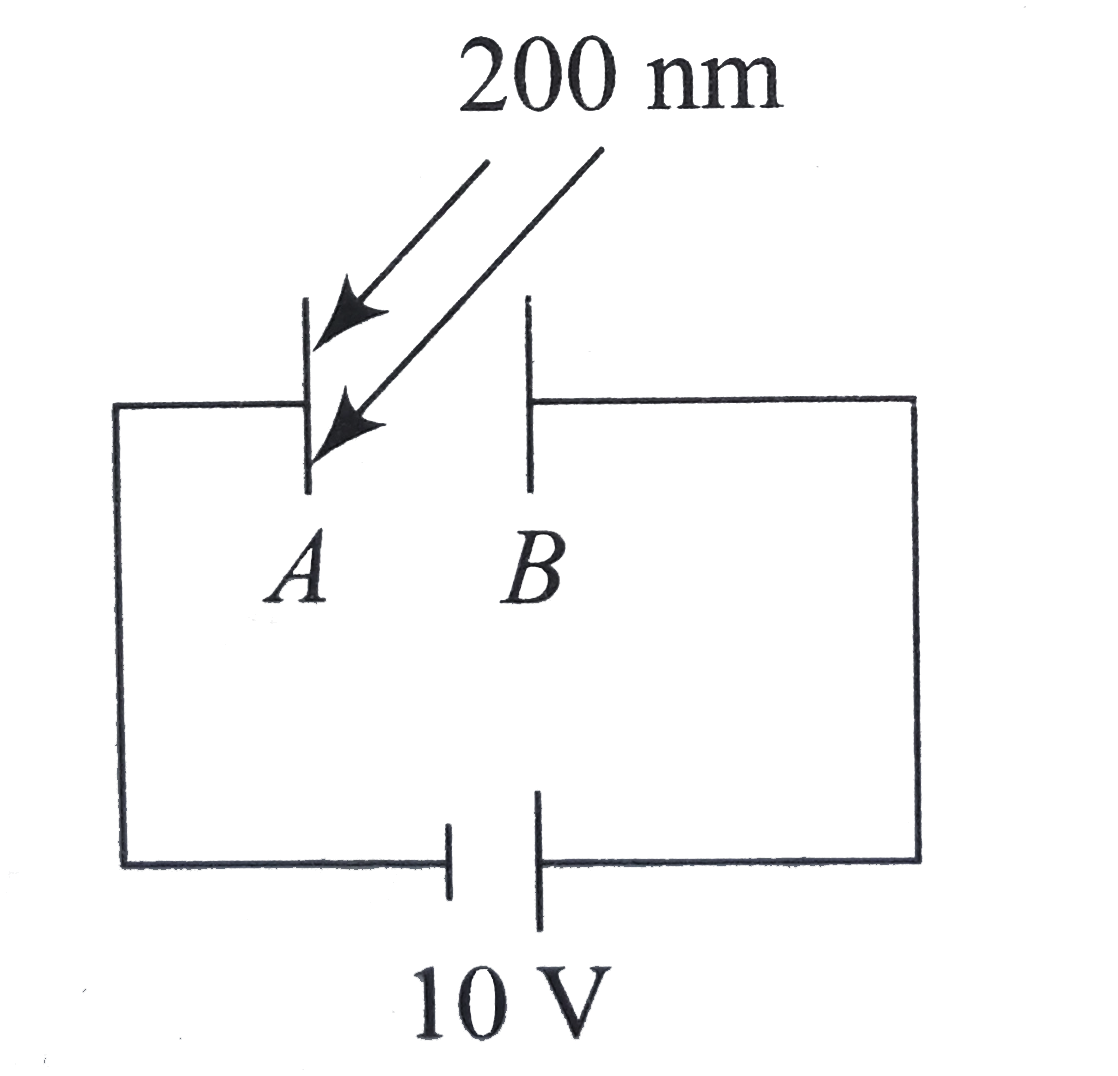A gas containining hydrogen-like ions, with atomic number Z, emits photons in transition n+2→n,wheren=Z These photons fall on a metallic plate and eject electrons having minimum de Broglie wavelength λof5Å. Find the value of Z , if the work function of metal is 4.2eV
To solve the problem, we will follow these steps:
Step 1: Calculate the Kinetic Energy of the Ejected Electrons
The de Broglie wavelength (λ) of the ejected electrons is given as 5Å (or 5×10−10m). The formula for de Broglie wavelength is:
λ=hp
where h is Planck's constant (6.63×10−34Js) and p is the momentum of the electron. The momentum can also be expressed in terms of kinetic energy (KE):
p=√2m⋅KE
Substituting this into the de Broglie equation gives:
λ=h√2m⋅KE
Squaring both sides:
λ2=h22m⋅KE
Rearranging for KE:
KE=h22m⋅λ2
Step 2: Substitute Known Values
The mass of the electron (m) is 9.1×10−31kg. Now substituting the values into the equation:
KE=(6.63×10−34)22⋅(9.1×10−31)⋅(5×10−10)2
Calculating λ2:
(5×10−10)2=25×10−20=2.5×10−19
Now substituting:
KE=(6.63×10−34)22⋅(9.1×10−31)⋅(2.5×10−19)
Calculating h2:
(6.63×10−34)2=4.39×10−67
Now substituting everything into the equation:
KE=4.39×10−672⋅9.1×10−31⋅2.5×10−19
Calculating the denominator:
2⋅9.1×10−31⋅2.5×10−19=4.55×10−49
Now calculating KE:
KE=4.39×10−674.55×10−49≈9.65×10−19J
Converting KE to electron volts (1 eV = 1.6×10−19J):
KE≈9.65×10−191.6×10−19≈6.03eV
Step 3: Relate Kinetic Energy to Photon Energy
The kinetic energy of the ejected electrons is related to the energy of the incident photons and the work function (ϕ) of the metal:
KE=Ephoton−ϕ
Given ϕ=4.2eV:
6.03=Ephoton−4.2
Solving for Ephoton:
Ephoton=6.03+4.2=10.23eV
Step 4: Calculate the Energy of the Photon Emitted from the Transition
For hydrogen-like ions, the energy of a photon emitted during a transition from n+2 to n is given by:
Ephoton=−13.6Z2(1n2−1(n+2)2)
Substituting n=Z:
Ephoton=−13.6Z2(1Z2−1(Z+2)2)
Simplifying:
Ephoton=−13.6Z2((Z+2)2−Z2Z2(Z+2)2)
Calculating (Z+2)2−Z2=4Z+4:
Ephoton=−13.6Z2(4Z+4Z2(Z+2)2)=−13.6⋅4(Z+1)(Z+2)2
Setting this equal to 10.23eV:
10.23=13.6⋅4(Z+1)(Z+2)2
Step 5: Solve for Z
Rearranging gives:
4(Z+1)(Z+2)2=10.2313.6
Calculating 10.2313.6≈0.7522:
4(Z+1)=0.7522(Z+2)2
Expanding and rearranging leads to a quadratic equation in Z. Solving this will yield the value of Z.
Final Answer
After solving the quadratic equation, we find:
Z=2
Similar Questions
An electron in Li2+ ion makes a transition from higher state n2 to lower state n1=6. The emitted photons is used to ionize an electron in H-atom from 2nd excited state. The electron on leaving the H-atom has a de Broglie wavelength λ−12.016Å.Find the value of n2.
Note : Use (12.016)2=150×14413.6×11,λÅ=√150KEeVView Solution
In Fig. electromagnetic radiations of wavelength 200nm are incident on a metallic plate A. the photoelectrons are accelerated by a potential difference of 10 V. These electrons strike another metal plate B from which electromagnetic radiations are emitted. The minimum wavelength of emitted photons is 100nm. If the work function of metal A is found to be (×x10−1)ev, then find the value of x. (Given hc=1240eV nm)View SolutionAn electron in hydrogen-like atom makes a transition from nth orbit or emits radiation corresponding to Lyman series. If de Broglie wavelength of electron in nth orbit is equal to the wavelength of rediation emitted , find the value of n . The atomic number of atomis 11.
View SolutionIf the wavelength of the nth line of Lyman series is equal to the de-broglie wavelength of electron in initial orbit of a hydrogen like element (Z=11). Find the value of n.
View SolutionAssertion: In a hydrogen atom energy of emitted photon corresponding to transition from n=2 to n=1 is such greater as compared to transition from n=∞ to n=2.
Reason: Wavelength of photon is directly proportional to the energy of emitted photon.View SolutionIf Photon having wavelength 6.2nmwas allowed to strike a metal plate having work function 50eV then calculate wavelength associated with emitted electron :
View Solutionwhat are the frequency and wavelength of a photon emitted during a transition from n = 5 state to the n =2 state in the hydrogen atom?
View Solutionwhat are the frequency and wavelength of a photon emitted during a transition from n = 5 state to the n =2 state in the hydrogen atom?
View SolutionIn a sample of excited hydrogen atoms electrons make transition from n=2 to n=1. Emitted quanta strikes on a metal of work function 4.2eV. Calculate the wavelength(in A) associated with ejected electrons having maximum kinetic energy.
View SolutionRadiation corresponding to the transition n=4 to n=2 in hydrogen atoms falls on a certain metal (work function=2.5 eV). The maximum kinetic energy of the photo-electrons will be:
View Solution

